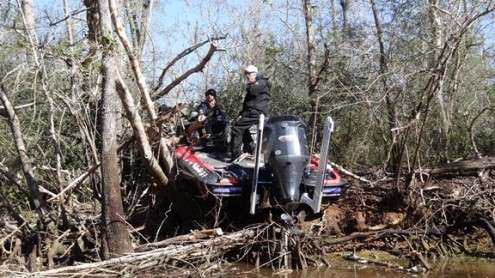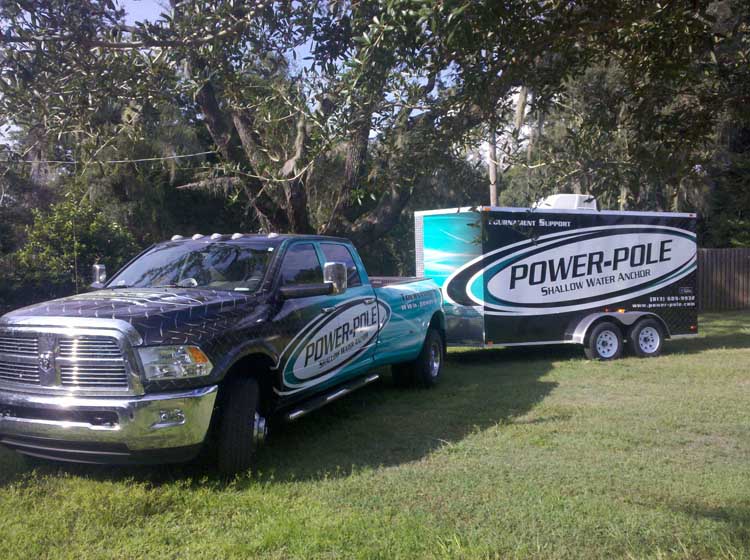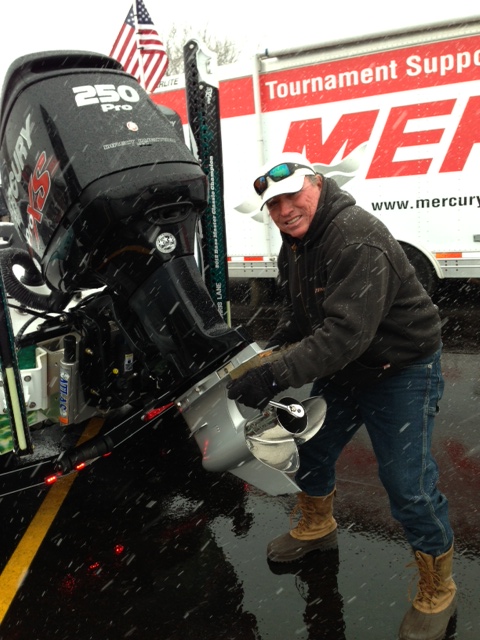
When it comes to high-stakes fishing, professional anglers will do almost anything to get to the fish … and that includes abusing their equipment.
If you watched The Bassmasters TV coverage of the 2013 Alabama River Elite event, you know what I’m talking about. Through several incredible sequences, viewers were privileged to all kinds of mechanical mayhem. Pros David Walker and Jared Miller stole the show by putting their equipment to the ultimate test. Both anglers found fish stacked in the rapids below Jordan Dam and, as we witnessed, went though hell and back to get to them.
Although less publicized, others experienced similar setbacks in that event. While attempting to shoot the shoals in another part of the river, Tommy Biffle destroyed the lower unit on his outboard. A service crew had to drive to his location in order to get him safely downstream.
At the Sabine River there were also multiple mishaps. Mike Iaconelli ran his Bass Cat up a 45-degree bank, wedging it in a stand of cypress trees, completely out of the water. That same week Brandon Palaniuk collided with an off-duty cop who was running the wrong side of the river. The resulting impact shattered the portside gunnel of Brandon’s boat.
While these were some of the more extreme incidents, the fact is, many lesser problems occur on almost a daily basis.
Let’s face it, it’s tournament fishing and stuff happens. With so much riding on the results, our boats become nothing more than a means to reach the fish. Trees, shoals and other boats aren’t the only obstacles we encounter. When the water’s high and the fish are back in the woods, you can bet the pros will follow them. They’ll use their boats like all-terrain vehicles, grinding up flooded brush as if it were soft milfoil.
Then there are manmade obstacles, like bridges and culverts. Some of you may recall the B.A.S.S. event on Kerr Reservoir where Randy Blaukat removed his seats, windshield and engine cowling, then pulled the plug on his Ranger so that it would take on water — all so he could pass beneath a low bridge and into a flooded creek. The maneuver required considerable time, effort and ingenuity, but it gave Randy a win and a tremendous amount of press.

And what about the time Mark Menendez plowed his way to victory in an Elite event on Lake Dardanelle? Unlike Blaukat’s dilemma, Menendez had to traverse super shallow rocks and mud as he ground his way through a culvert into a silted backwater.
Were their efforts worth it? You bet. But man did it take a toll on their equipment!
The Service Yard
Although our equipment is built to endure even the harshest treatment, things sometimes break. And when they do, it’s nice to know we have back up.
At each Elite Series event, service techs from all the major boat and outboard companies collect to form what’s referred to as “the service yard.” Companies like Mercury, Yamaha, Triton and Ranger set up mobile repair shops, complete with everything needed to keep us on the water. With them are techs from various marine accessory companies, including Motor-Guide, Power-Pole and T-H Marine. Even electronics companies are present. And though these guys may represent competing brands, they’re like a big family — a brotherhood of mechanics, so to speak.
Like us, they live on the road, traveling from town to town. They stay at the same hotels, eat at the same restaurants, and they’re there for us whenever we need them.

The service yard is usually located at the main boat ramp where the take-off and weigh-in ceremonies are held. The crews arrange their big trucks and trailers much like that of pit crews at a NASCAR event. When one has a big job to do, techs from other trailers will often chip in. They swap tools and know-how in order to get the job done quickly and correctly. It’s pretty cool to watch how efficiently they work, especially when pressed for time.
Another part of their responsibilities is to monitor our equipment. Oftentimes we’re testing new products, and they need feedback on how it’s performing, particularly under adverse or extreme conditions. And as any service tech can tell you, tournament fishing dishes out plenty of that.
Although the average angler would never put his equipment through what we will, he or she still realizes a benefit in the long run. It’s our field testing that makes the end product more reliable and durable.
So the next time you’re watching your favorite pro battling the competition, keep in mind that he’s not entirely on his own — there’s a team of factory technicians behind him, making sure he can compete at the top of his game.

